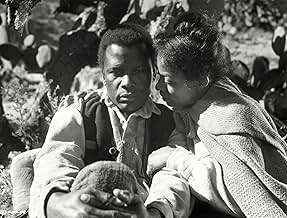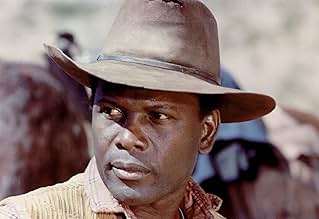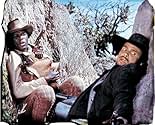IMDb रेटिंग
6.6/10
3 हज़ार
आपकी रेटिंग
अपनी भाषा में प्लॉट जोड़ेंA wagon master and a con-man preacher help freed slaves dogged by cheap-labor agents out West.A wagon master and a con-man preacher help freed slaves dogged by cheap-labor agents out West.A wagon master and a con-man preacher help freed slaves dogged by cheap-labor agents out West.
Kenneth Menard
- Little Henry
- (as Ken Menard)
फ़ीचर्ड समीक्षाएं
I don't understand how someone could classify this film as a "comedy". It did have it's comedic moments, but no more than any other Western or Drama. Then that false comment ends up on the front page of the IMDb? Weird. This was a first rate Western by any standard. At a time when Hollywood had no interest in making such films. Blaxploitation films and comedies were the rules of the day. Poitier makes a great cowboy and fine director here. I suspect the reason this film is/was not more popular is that there were so few good guys of the White persuasion. The one fair and honest White man was the town Sheriff, who was quickly killed off by another White man for this very reason.
I just saw this movie for the first time on Turner Classic Movies tonight. I had heard about it, but missed it. It's just another shoot-'em-up horse opera, but this time with a difference. It's one of the only westerns ever made that is a story about black people in the Old West, with black actors in the lead roles. Harry Belafonte is excellent as the Preacher. Sidney Poitier is also very good, and although the story contains the full compliment of standard cowboy movie clichés---shoot-outs, posse chases, bank robberies, whining ricochet sounds, etc.---, it's very entertaining. The vast majority of Hollywood westerns are exclusively white, and feature virtually no black people at all. Indians are almost always featured as pidgin-speaking cigar-store cartoon characters, with white actors usually in the speaking parts. Some idiot composer came up with the pounding tom-toms, descending minor theme music played by trombones and low brass whenever Indians come into the picture. It's unbelievable how ridiculous this music is. Hollywood has a lot to answer for in its racist treatment of minorities throughout its early history, which has never been fully addressed. So it's great to see a western like Buck and The Preacher that is different. As a result, it's a lot better than your average western, even though it milks the same old clichés.
After civil war, the free black people headed to west in searching for a free land, Sidney Poitier was in charge to guide this settlers toward to western lands, however a bunch leading by the evil Deshay (Cameron Mitchel) pursued them, try out convincing by force to return to Louisiana, meanwhile appears the preacher (Belafonte) the best character in the movie, an easy going man who hidden behind in a mask of God's man, he is malicious, raunchy and cheater, quite often he speech set phases from the Bible, Buck realizes that the preacher isn't trustful, nevertheless has to live together in such circumstances, these opposing forces are the highlight of the picture, developing a perfect chemistry between two distinct characters, also it has an indelible black humor, a rare movie made at Blaxploitation era, shot at Durango on Mexico displaying a dry and beautiful landscape, enjoyable and highly underrated!!
Resume:
First watch: 1980 / How many: 5 / Source: TV-DVD / Rating: 8.5
Resume:
First watch: 1980 / How many: 5 / Source: TV-DVD / Rating: 8.5
It's shortly after the abolition of slavery and Black people all over the south seek greener pastures where they don't have to be subjected to Jim Crowism. Some would head west with a wagon master showing them the way. And sometimes the greedy white people of the south wouldn't want to let their labor go so they'd send night riders after them to bring them back.
Buck (Sidney Portier) is a wagon master leading a group west. The Preacher (Harry Belafonte) is an opportunistic shuckster who finds himself a part of the Buck-led wagon train. The two of them have to be heroes in a sense in order to get this wagon train west.
I really appreciate this movie being made in the 70's when so many blaxploitation films were made. Instead of pimps, hoes, hustlers, and drug dealers, this movie is about positive black male figures in a western. Besides the terrible movie, "Posse," with Mario Van Peebles, I hadn't seen a Black western. I liked the history this movie presented (however dramatized), what it stood for, and the actors in it. Yes, I have seen better westerns--meaning more entertaining--but I can't readily recall a more significant western.
Buck (Sidney Portier) is a wagon master leading a group west. The Preacher (Harry Belafonte) is an opportunistic shuckster who finds himself a part of the Buck-led wagon train. The two of them have to be heroes in a sense in order to get this wagon train west.
I really appreciate this movie being made in the 70's when so many blaxploitation films were made. Instead of pimps, hoes, hustlers, and drug dealers, this movie is about positive black male figures in a western. Besides the terrible movie, "Posse," with Mario Van Peebles, I hadn't seen a Black western. I liked the history this movie presented (however dramatized), what it stood for, and the actors in it. Yes, I have seen better westerns--meaning more entertaining--but I can't readily recall a more significant western.
This is a fictional movie inspired by how things really were back in the 1800s, in the years following the Civil War and granting slaves their freedom. The white supremacists wanted the black to stay on the farms and work there and would sometimes take drastic, and illegal, means to drive them back.
I found it on a nicely restored version, a Criterion Collection movie from my public library.
Sidney Poitier, who also directed, is Buck, a cowboy who gets paid to lead wagon trains towards their destination. The featured group of migrants are from St. Anne Parish in Louisiana. (While there are many "Saint" parishes in Louisiana, there is no Saint Anne.)
Harry Belafonte, long time Poitier friend, both with Carribean roots and born less than two weeks apart, is Preacher. He travels with a Holy Bible he is quick to display, but as the movie goes on we see that he isn't really a preacher but a rascal that eventually serves a good purpose.
The action of the movie has a band of rogue white supremacists on horses periodically attacking the black migrants, wrecking their wagons, killing some men, all in an attempt to get them to return to their former homes. Buck and the Preacher band together to protect the migrants and get rid of the bad guys.
An entertaining movie, especially for his place in history. As the DVD extras clarifies, the original "cow boys" were black, they were called that to differentiate them from the white "cow hands."
I found it on a nicely restored version, a Criterion Collection movie from my public library.
Sidney Poitier, who also directed, is Buck, a cowboy who gets paid to lead wagon trains towards their destination. The featured group of migrants are from St. Anne Parish in Louisiana. (While there are many "Saint" parishes in Louisiana, there is no Saint Anne.)
Harry Belafonte, long time Poitier friend, both with Carribean roots and born less than two weeks apart, is Preacher. He travels with a Holy Bible he is quick to display, but as the movie goes on we see that he isn't really a preacher but a rascal that eventually serves a good purpose.
The action of the movie has a band of rogue white supremacists on horses periodically attacking the black migrants, wrecking their wagons, killing some men, all in an attempt to get them to return to their former homes. Buck and the Preacher band together to protect the migrants and get rid of the bad guys.
An entertaining movie, especially for his place in history. As the DVD extras clarifies, the original "cow boys" were black, they were called that to differentiate them from the white "cow hands."
क्या आपको पता है
- ट्रिवियाOn the advice of his future wife Joanna Shimkus, Sidney Poitier took over directorial duties from Joseph Sargent when he became dissatisfied with the film's point of view. As a result, this turned out to be Poitier's debut behind the camera and he would go on to direct eight more pictures.
- गूफ़When Ruth blows out the flame in the lantern, there is a slight delay before the light goes out in the cabin and then another slight delay before the "moonlight" comes up.
- भाव
Buck: Which way are you ridin', Preacher?
The Preacher: Well, that's not exactly settled in my mind yet.
Buck: Well, you got three possibilities.
The Preacher: Oh?
Buck: North, south or east.
The Preacher: What happened to west?
Buck: We're going west.
- क्रेज़ी क्रेडिटOpening credits prologue: The Civil War was over and by law the slaves were freed. But when the promise of land and freedom was not honored, many ex-slaves journeyed out of the land of bondage in search of new frontiers where they could be free at last.
They placed their hopes in the hands of the few black wagonmasters that knew the territories of the West.
None of this came easy, for for not only did they have to overcome a hostile wilderness, but nightriders and bounty hunters were hired by persons unknown to hunt them down and turn them back to the fields.
This picture is dedicated to those men, women and children who lie in graves as unmarked as their place in history.
- कनेक्शनFeatured in The Dick Cavett Show: 1 मई 1972 को प्रसारित एपिसोड (1972)
टॉप पसंद
रेटिंग देने के लिए साइन-इन करें और वैयक्तिकृत सुझावों के लिए वॉचलिस्ट करें
- How long is Buck and the Preacher?Alexa द्वारा संचालित
विवरण
बॉक्स ऑफ़िस
- बजट
- $20,00,000(अनुमानित)
- दुनिया भर में सकल
- $2,762
इस पेज में योगदान दें
किसी बदलाव का सुझाव दें या अनुपलब्ध कॉन्टेंट जोड़ें

































